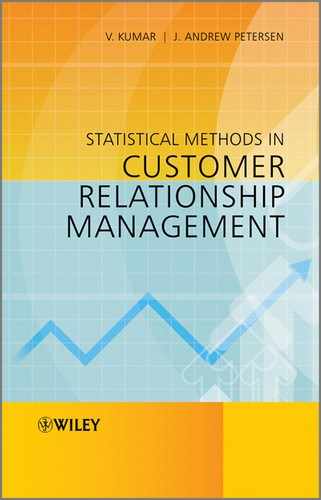2.3 The Significance of Customer Retention
The increases in customer data collection, storage, and analysis have impacted not only the customer acquisition process, but also customer retention. This is evident from that fact that since the early 1960s, companies have changed their focus from short-term acquisition and transactions to long-term relationships and CLV [9]. In fact, retention studies indicate that for every 1% improvement in customer retention rate, a firm's value increases by 5% [10]. However, as important as customer retention may be in adopting a CRM strategy, it is important to note that many factors must be taken into account during the decision and process of customer retention.
Who to retain can often be a difficult question to answer. This is because the cost of retaining some customers can exceed their future profitability and thus make them unprofitable customers. When to engage in the process of customer retention is also an important component. As a result, firms must monitor their acquired customers appropriately to ensure that their customer loyalty is sustained for a long period of time. Finally, identifying how much to spend on a customer is arguably the most important piece of the customer retention puzzle. It is very easy for firms to over-communicate with a customer and spend more on his/her retention than the customer will ultimately give back to the firm in value.
Identifying who to retain has become more intricate with advances in data modeling techniques. In effect, data availability decides the way in which a firm measures an acquired customer's future profitability, and, correspondingly, determines whether or not that customer is worth the money and effort required to retain him/her. Mobile carrier Sprint Nextel engaged in this process in a rather peculiar and different way by firing 1000 customers in 2007. The firm had determined that around 1000 of its customers had become unprofitable. That is, Sprint was spending more on retaining these customers than their level of purchase contributions. As a result, Sprint let go of these 1000 unprofitable customers. In order to minimize backlash for this unorthodox and abrupt cancellation of service, Sprint applied a credit to those customers' accounts that brought their credit to zero [11]. This is one of many examples of companies actively engaging in measuring whether or not a customer is worth retaining. In helping to make such decisions, the CLV metric can provide better guidance than any other customer-level metric.
When to engage in the activity of retaining a customer can be a highly misunderstood and undervalued component in customer retention. Monitoring a customer's purchasing and attitudinal behavior is vital in understanding when a firm should aggressively and actively pursue retention of that customer. This is important for two reasons. First, firms can often lose sight of a customer's loyalty and lose its profitable customers, thereby creating undue financial stress. Second, monitoring customer behavior allows the firm to identify the attitudinal changes in that customer. This is important because understanding the attitudinal changes of a customer with regard to the firm's brand advises the firm on how and when to be aggressive in its retention strategies for that particular customer.
Determining how much to spend on a customer is an important assessment involved in identifying who and when to retain. Innovations in statistical modeling now allow firms to measure a customer's future value and profitability to the firm, which makes it easier to make decisions on how much to spend compared to the future value. This logical approach to customer retention calls for data pertaining to several aspects of customer transactions over a period of time, and advanced modeling techniques. This analysis also accounts for a customer's responsiveness to retention efforts, as this determines the method of communicating the intention to retain and the related costs attached to it.
Researchers and managers alike are placing more importance on the study of customer retention and its impact on company profits. In both B2B and B2C firms, model-based approaches are becoming increasingly available, and thus necessary, in both contractual and non-contractual relationships. In Chapter 4, we will introduce and discuss in detail the various metrics and model-based approaches being applied to customer retention. The chapter will delve into models that include: (a) explaining customer retention or defection, (b) predicting the continued use of the service relationship through the customer's expected future use and overall satisfaction with the service, (c) renewal of contracts using dynamic modeling, (d) modeling the probability of a member lapsing at a specific time using survival analysis, (e) modeling the duration of relationship using the negative binomial distribution (NBD)/Pareto model and the proportional hazard model, (f) use of loyalty and reward programs for retention, and (g) assessing the impact of a reward program and other elements of the marketing mix.
However, despite the importance of customer retention as a single link in the chain of CRM, it is necessary for managers to take a holistic and comprehensive view of the CRM process. One of the biggest mistakes that managers currently make is in viewing customer acquisition and retention as separate processes. Although most studies assess acquisition and retention separately, we propose several models and metrics through which managers and firms can link the two together in order to improve their CRM process. In Chapter 5, we will propose several models linking the acquisition and retention processes that include: (a) use of nonlinear programming to optimize budget allocation between acquisition and retention spending, (b) jointly modeling the acquisition and retention of a membership available to existing members of an organization, and (c) allocation and distribution of marketing spending between customer acquisition and retention across communication channels.
